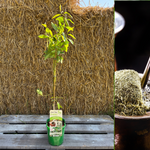Subscribe and save 10%!

Yerba Mate 'GARDEN 2 CUP®' 50-80 cm (Ilex paraguariensis)
385 SEK
Unit price perExpected delivery date: 20 December to 27 December.
Applies to orders within Sweden. For other countries - see our delivery terms .
In stock - Ready to be shipped
Share
385 SEK
Unit price per1 Yerba Mate plant of the variety 'GARDEN 2 CUP®' - current height 40-60 cm
The picture is just an example, this batch of plants is taller and stronger.
Common name: Mate, Yerba Mate, Paraguayte, Tereré
Scientific name: Ilex paraguariensis
Family: Aquifoliaceae
Plant history & use:
The Yerba Mate plant originates from the subtropical regions of South America. It was originally consumed by the Guarani people for its "energizing and healing properties."
The drink mate is a popular alternative to coffee as the plant's caffeinated leaves are dried and ground/crushed to brew the stimulating drink . The leaves also contain vitamin B6 and magnesium which, among other things, help reduce fatigue and balance sleep habits.
Mate contains around 80mg of caffeine per cup, while traditional tea ( Camellia sinensis ) contains around 40mg for green tea, or 60mg for black tea; coffee contains 100-200+mg of caffeine per cup - this gives an idea of the invigorating effect of the different drinks. However, the other active ingredients of each drink, in addition to caffeine, also have an effect on the level of alertness or freshness, but caffeine is an easy way to compare the different drinks. Mate also contains theobromine, which is a well-known substance due to its occurrence in cocoa.
The ground/crushed leaves are normally simmered in hot water. If the drink is cold brewed instead, it is called tereré. The cold drink tereré is consumed mostly in the warmer regions of South America. Often, various types of refreshing and medicinal herbs are added to the drink to be consumed in conjunction.
In South American countries like Brazil, Argentina, Uruguay and Paraguay, mate is so common that it is more common than coffee - something that can be difficult for us Europeans to understand. Even in the USA, the drink is widely available to buy in stores. Outside America, mate has spread in popularity to the Levant (Syria & Lebanon etc.).
The leaves are also rich in vitamins A, B1, B2, B3, C and E; the minerals potassium, calcium, manganese, iron, selenium, phosphorus and zinc; and a range of flavonoids which help protect the body against oxidative stress.
There are different ways to make mate. Some mate blends have been fermented, while blends made using other methods skip this step and carry out only a short drying before grinding the leaves - the latter variant often contains only leaves, is very finely ground and produces a neon green colored drink. Other mixtures contain both twigs and leaves - and some have also undergone a smoking process over fire.
Culture:
Yerba Mate thrives best in a regularly warm climate with a slightly higher humidity. The plant can withstand short-term temperatures down to -8ºC, however, it is probably nothing that allows outdoor winters even in the warmest parts of the country. However, you can overwinter the plant in cold spaces such as frost-free greenhouses, storage rooms or basements as long as it does not get below freezing for a long period. You can also overwinter Yerba Maten indoors to move outside during the warmer months.
Plant your Mate plant in a pot with well-drained soil, place outdoors in full sun and wind-protected location from March/April (no freezing temperatures for extended periods) - if you have a greenhouse, it is an excellent place for Yerba Mate. Move for overwintering when freezing temperatures approach.
Leaves begin Normally harvested in the spring from the plant's 4th year.
Yerba Mate is an evergreen plant, so if you manage to get it to thrive, it will provide its surroundings with greenery all year round.
Features:
Year: Perennial
Growing position: sun
Height: 4-6 meters
Growing zone: hardy down to -8 ºC for short periods
- Choosing a selection results in a full page refresh.
- Opens in a new window.











